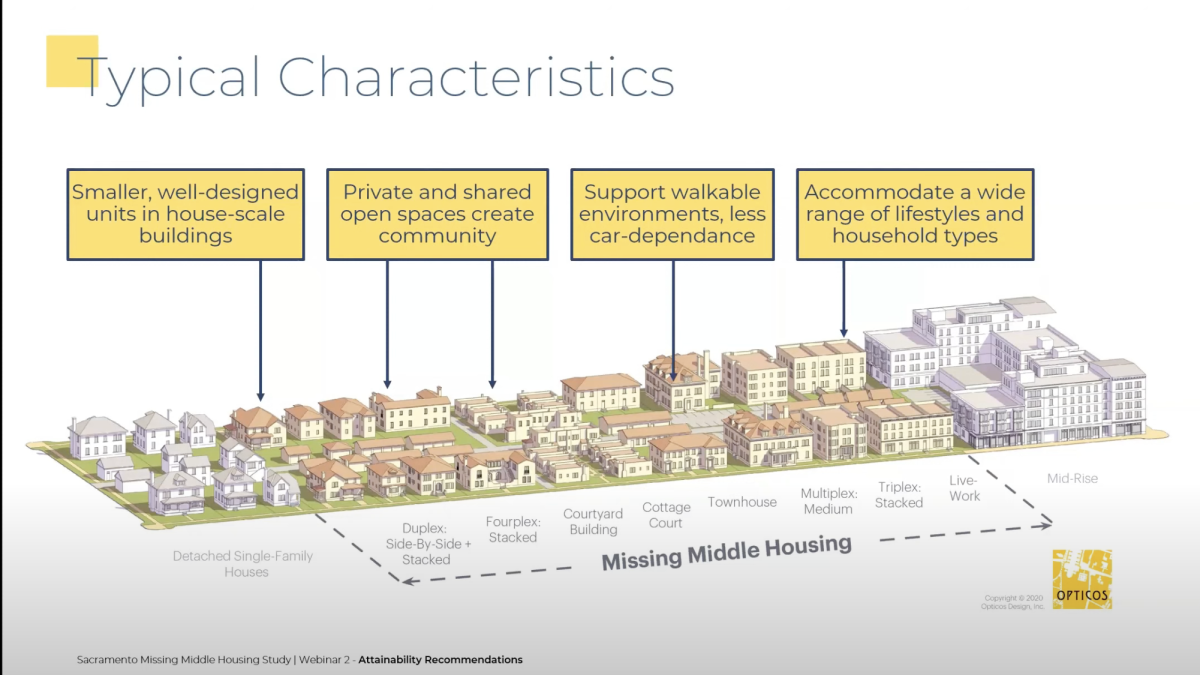When I was in middle school, many of my school friends lived very far away from me, so planning activities with them or going over to their houses was difficult. My mom has made a running joke about how all of my friends live far away, even though we go to the same neighborhood school. But why does this happen? Or a better question is, how can we fix it? My solution comes down to the development of housing and suburban areas.
If you were to look at the neighborhood that I live in from a top-down view, you would see single-family homes stretching for miles with public and private commercial buildings sprinkled in between. Many of the commercial and residential portions of my area are separated into specific areas, rather than being integrated. This creates a society with a low population density. This is why my friends always live so far away, because of single-family homes and zoning laws. The implementation of middle housing and new and improved zoning laws could be a solution to this complex problem.
Middle housing, defined by Local Housing Solutions, is “housing types that fall somewhere in between a single-family home and mid-rise apartment buildings – such as townhomes, duplexes, triplexes, and courtyard clusters.” These types of homes not only increase the population density of suburban areas through their ability to fit multiple living spaces into one unit, they also have a plethora of other benefits.
With the increase in population density in suburban areas, public transportation becomes more practical because urban centers are more common and accessible. In turn, these new housing types create more non-car-dependent neighborhoods, where people live closer to jobs, stores, transit hubs–and schools. This would allow me to travel to my friends’ houses quicker, cheaper, and without my parents having to drive me. With an increase in public transportation, there will be less congestion on the road from fewer drivers and will reduce the need for large highways.
As more middle housing is created, it will increase the supply of homes without the need for further expansion and infrastructure, which will decrease the prices of houses. The main problem with the housing market is that there is such a low supply, but with increased integration of middle housing, this supply problem will be solved.
As more middle housing is established, it will help rid neighborhoods of residential segregation. Because of single-family homes’ pricey nature, it leads to lower-income families being put into poorer neighborhoods. This phenomenon is described by MIT Press Direct, “Residential segregation produces negative socioeconomic outcomes for minority groups, influencing disparities in educational opportunity, access to health care and food, and employment.” This problem can be solved with the expansion of multi-family houses driving the price of housing down.
Public transportation and increased walkable neighborhoods will phase out car dependency, creating a greener and more sustainable society. This comes without large societal changes in energy use or ways of life. Also, road space will be more free with the reduction of car parking spaces, so expansion will be even less necessary.
Even with all of these benefits, something is standing in its way: U.S. zoning laws that restrict the construction of middle housing, which has led to the missing middle housing crisis that we see today. During the 1910s, zoning laws that created specific areas of where types of buildings can be built, were enacted to protect Americans from clashing building types devaluing their home value. Although today, these laws have a tight grip on the American housing market, now negatively affecting your everyday American with restrictive laws. According to planetizen.com, “ Around 75% of land zoned for housing in major U.S. cities is zoned for single-family housing. In California, single-family zoning accounts for between half and three-quarters of all developable land in the state.”
Cities and municipalities are realizing the severity of the housing crisis that they have on their hands, shown by CNN stating that “Homes cost more than they ever have over the past 30 years, even when adjusting for inflation, and housing construction has failed to keep up with demand. The US housing market is short some 6.5 million homes.”
Some cities have taken it into their own hands to fix our zoning problem themselves. The first city to end single-family housing zoning laws is Minneapolis, being widely successful in its attempt to create a more affordable and population-dense society. Oregon also tried to tackle this problem with the passing of the House Bill in 2001 that aimed at increasing the diversity of middle housing in the state. Buffalo, NY implemented a form-based code known as the Buffalo Green code, which was designed to incentivize walkable, mix-use neighborhoods.
The way we structure our neighborhood is changing for the better and everyone needs to get with the times. No matter where you stand on the political spectrum, you should want an increased implementation of middle housing in your neighborhood and around the world.






































Evan Nguyen • Feb 6, 2024 at 12:20 AM
I believe that middle housing could solve issues regarding low-population density, but may decrease the standard of living. Denser population areas as a result of changes to zoning laws could also reduce the need for private transport, incentivizing people to use public transport instead.
Matteo • Feb 4, 2024 at 2:35 PM
It would be unwise to eliminate existing zoning laws. As you mentioned in your article, these zoning laws were first introduced in the 1910’s, largely in order to ensure that overcrowded tenements that were not safe for human inhabitance would not have to be occupied. Any attempt to move families into large apartment complexes or eliminate residential neighborhoods would be a large infringement on universal rights to property, and pursuit of happiness. These laws were passed for a reason, (in order to elevate the human standard of living), and this standard has not decreased over the last 100 years.
Grant Elliott • Feb 7, 2024 at 11:50 AM
You have completely misunderstood what I was trying to say. I believed that the dominant housing type should be changed, not eliminated. There are very few examples of middle housing in America and needs to be increased. Middle housing doesn’t Include large Apartment blocks. The buildings we have now are either single family houses or large apartment blocks. I want to expand that to have larger houses in residential areas. I never said I wanted to move families. Also, how does this infringe on happiness? I want to give houses to more people.
gjw • Apr 15, 2024 at 4:32 PM
This doesn’t seem very well thought out, but it’s a good start. Increasing population density comes with a number of side effects, namely, problems with increased traffic, noise pollution, gentrification, and a number of bureaucratic/legal hurdles. It might seem like a practical solution, but I assure you it is not.
Joseph VanDenBerg • Feb 2, 2024 at 10:16 PM
I also agree heavily as middle housing is not a polar extreme and can fit a ton of people.
Mia Golden • Feb 2, 2024 at 5:59 PM
I really liked your article! I didn’t realize all the benefits that implementing more middle housing would have. I also learned about the difficulties that current zoning laws create. I want to live in a walkable city and be able to see my friends and gain access to necessities like groceries within walking distance or by means of public transportation. The types of housing and cities you describe are much more sustainable and more appealing to me.
Grant Elliott • Feb 7, 2024 at 11:51 AM
Thank you!